
About UsThe Numismatic Bibliomania Society is a non-profit organization promoting numismatic literature. For more information please see our web site at coinbooks.org SubscriptionsThose wishing to become new E-Sylum subscribers (or wishing to Unsubscribe) can go to the following web page link MembershipThere is a membership application available on the web site Membership Application To join, print the application and return it with your check to the address printed on the application. Membership is only $15 to addresses in the U.S., $20 for First Class mail, and $25 elsewhere. For those without web access, write to: David M. Sundman, Secretary/TreasurerNumismatic Bibliomania
Society AsylumFor Asylum mailing address changes and other membership questions, contact David at this email address: dsundman@LittletonCoin.com SubmissionsTo submit items for publication in The E-Sylum, just Reply to this message, or write to the Editor at this address: whomren@coinlibrary.com
BUY THE BOOK BEFORE THE COINYou won't regret it! |
- WAYNE'S WORDS: THE E-SYLUM JUNE 5, 2011
- SKLOW MAIL BID SALE NO. 13 CLOSES JUNE 11, 2011
- SALE RESULT: PLATED CHAPMAN STICKNEY SALE CATALOG
- NEW BOOK: 2012 STANDARD CATALOG OF WORLD COINS 1901-2000
- NEW WEB SITE: SELLCOINBOOKS.COM
- KRAUSE PUBLICATIONS RELAUNCHES NUMISMATICNEWS.NET
- ANS COMMISSIONS ERIC NEWMAN MEDAL
- MORE ON ERIC NEWMAN
- READER COMMENTS ON THE WOODWARD & LOTHROP STORE COIN DEPARTMENT
- NOTES FROM E-SYLUM READERS: JUNE 5, 2011
- MORE ON THE COREY'S OINTMENT COUNTERSTAMP
- AMERICAN COINS IN THE SHORTHOUSE COLLECTION
- AN ODD AND CURIOUS CURRENCY: CIGARETTE BOXES IN GERMANY
- GOLD, SILVER BECOMING LEGAL CURRENCY IN MORE STATES
- BIBLIOMANIACS: HIGH ON LITERATURE?
- FEATURED WEB SITE: GEORGE WASHINGTON INAUGURAL BUTTONS
WAYNE'S WORDS: THE E-SYLUM JUNE 5, 2011

Among our new subscribers this week are Patricia Quintero, Dave Kranz, Steve Lowry, Harold Tice and Harald M. Suedkamp. Welcome aboard! We now have 1,429 email subscribers, plus 145 followers on Facebook, including Grace Anna and Rodriguez Otto.
This week we open with a sale reminder from David Sklow, a sale follow-up from Rich Hartzog, and a few updates from Krause Publications.
Other topics include an ANS medal for Eric Newman, reader comments on the Woodward & Lothrop store coin department, and American coins in the Shorthouse collection. Have a great week, everyone!
Wayne Homren
Numismatic Bibliomania Society
SKLOW MAIL BID SALE NO. 13 CLOSES JUNE 11, 2011
Bidding Reminder: Hope everyone had a great Memorial Day Weekend!
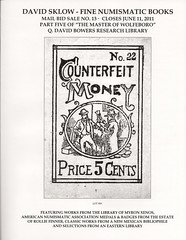 DAVID SKLOW - FINE NUMISMATIC BOOKS
DAVID SKLOW - FINE NUMISMATIC BOOKS
MAIL BID SALE NO. 13 CLOSES JUNE 11, 2011
PART FIVE OF "THE MASTER OF WOLFEBORO"
Q. DAVID BOWERS RESEARCH LIBRARY
From the research & source library of Q. David Bowers are offered over 300 lots on numismatics. Including an American Bond Detector; an Original set of Numisma by Frossard; set number 5 of the deluxe bound Armand Champa Library catalogs; letters between QDB and John J. Ford, Jr.; the paste-up plates for the Taylor sale of Colonials 1987; super deluxe presentation copy number 2 of the Eliasberg & Brand collections; a set of The Essay Proof Journals; special, priced, large paper, bound, Cogan Sale of the J.K. Wiggins Collection; six works by Snelling bound in one volume; over 125 Director of the Mint reports 1852-1977; Bankers Magazine and Statistical Register, ex: John J. Ford Jr.; 65 lots of Bank Histories;
The sale also features classic selections from the library of numismatic publisher and literature dealer Myron Xenos, to include hundreds of 19th and 20th century auction catalogs, An Essay on Medals by Pinkerton, and numerous works on coinage of China, Japan and the Far East.
Over one thousand-three hundred color photographs of Large Cents 1816-1843 by William Noyes.
Library from New Mexico, featuring deluxe bound auction catalogs, numerous standard reference works, some deluxe editions and original Early Coins of America by Crosby.
A beautiful example of Medals & Medallions Relating to Architects by Eidlitz.
Badges & Medals of the American Numismatic Association, from the estate of Rollie Finner. Including the very rare 1991 Centennial three piece medals set, bronze, silver & gold in special presentation wooden box.
Bidders may enter bids by mail, telephone, email or fax. The sale closes at 8pm mountain time, June 11, 2011, however, any bids left on our answering machines or sent by email or fax on or before midnight on closing day will be accepted.
DAVID SKLOW FINE NUMISMATIC BOOKS
P.O. BOX 6321
COLORADO SPRINGS, CO 80934
TEL: (719) 302-5686
FAX: (719) 302-4933
finenumismaticbooks@aol.com
www.finenumismaticbooks.com
SALE RESULT: PLATED CHAPMAN STICKNEY SALE CATALOG
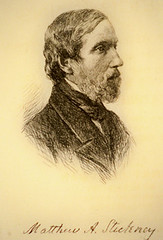 Rich Hartzog of World Exonumia sold a copy of the 1907 Stickney Chapman catalog on eBay (item #
320705044846.
This hardbound copy had 20 original photographic plates which included the 1804 Dollar, Brasher Doubloon and other rarities.
Rich Hartzog of World Exonumia sold a copy of the 1907 Stickney Chapman catalog on eBay (item #
320705044846.
This hardbound copy had 20 original photographic plates which included the 1804 Dollar, Brasher Doubloon and other rarities.
This version had the Stickney etching in the front, with the prices realized bound in. The catalog sold for $1,575 with 45 bids from numerous bidders. The catalog was consigned to Hartzog from a well-known midwestern coin dealer. See
www.exonumia.com
for Hartzog's web site.

NEW BOOK: 2012 STANDARD CATALOG OF WORLD COINS 1901-2000
 In a coin market that is always changing it's good to have a reference catalog that not only helps you survive the changes, but also helps your coin collection thrive. That's what 2012 Standard Catalog of World Coins 1901-2000 does, and does well.
In a coin market that is always changing it's good to have a reference catalog that not only helps you survive the changes, but also helps your coin collection thrive. That's what 2012 Standard Catalog of World Coins 1901-2000 does, and does well.
This top-selling coin guide contains nearly 1 million values for coins minted around the world, between 1901 and 2000.With few exceptions, the values stated in this new 39th edition have risen from those of previous cases, and in some cases, the values have increased substantially based on market demands. In addition to current values, this book also contains 60,000 actual-size illustrations of coins including the front and back (obverse and reverse). These illustrations are great for helping to accurately identify coins which is an essential part of grading and pricing your coins.
With listings for gold, platinum, palladium and silver coins, this book also helps you chart a course of success in today's turbulent precious metals market by providing you with:
- Total coin weight
- Fineness
- Actual precious metal
- Trusted by everyone from researchers and collectors to dealers and historians, this book is the one coin guide you need.
Product Type: Paperback
Page Count: 2352
Size: 8.25''w x 10.875''h
ISBN: 978-1-4402-1572-8
Other Features: 50000 Black & White Illustrations
For more information, or to order, see:
2012 Standard Catalog of World Coins - 1901-2000
(www.shopnumismaster.com/product/2012-standard-catalog
-of-world-coins--1901-2000-y1742/world-coins/)
NEW WEB SITE: SELLCOINBOOKS.COM

Meghan McKeon of F+W Media, Inc. writes:
Krause Publications has developed a new website to help retail outlets evaluate and order KP numismatic products -- www.sellcoinbooks.com. Attached is additional information.
Krause Publications, a leading producer of books, magazines, web properties and events covering coin and paper money collecting, has launched a new website to help retail outlets evaluate and order KP numismatic products: www.sellcoinbooks.com.
At www.sellcoinbooks.com, retail customers can find a wide range of information on Krause Publications coin and paper money products, including:
-Frontlist title information like price, ISBN, SKU, release date, etc.
-Best-selling and editor's choice titles.
-Merchandising tips.
-Promotional information on KP's Pass Through Program.
-Catalog links, sales representative contacts, order forms and more.
Sellcoinbooks.com is organized in easy-to-identify categories: U.S. coins, U.S. paper money, world coins, world paper money, investment/precious metals, and coin folders. There is also a section dedicated to KP's CD products. Ordering information is available for both domestic and international customers.
To visit the site, see: www.sellcoinbooks.com
KRAUSE PUBLICATIONS RELAUNCHES NUMISMATICNEWS.NET
Krause Publications has relaunched NumismaticNews.net, the online home of its popular weekly coin magazine, Numismatic News.
The relaunched site features many popular carryovers from the old NumismaticNews.net, along with some new ones:
-Blogs from KP numismatic experts Dave Harper, Bob Van Ryzin, George Cuhaj and Tom Michael, along with the new Community Voice blog by online editor Lisa Bellavin.
-All the latest numismatic news.
-Popular features like Item of the Week, Mint States, Class of '63 and Coin Clinic.
-Free educational downloads for site registrants.
-Online seminars on popular numismatic topics, hosted by Harper.
-Regular sweepstakes.
-A marketplace featuring classified advertising and an industry directory.
"We're really excited about the new site, especially the Community Voice blog," said Bellavin. "Users can register on the site and submit feedback on the weekly topic of interest, and see themselves featured."
For more information visit www.numismaticnews.net
SALE REMINDER
DAVID SKLOW - FINE NUMISMATIC BOOKSJUNE 11, 2011 - MAIL BID SALE NO. 13
BIDDERS MAY ENTER BIDS BY MAIL, TELEPHONE, EMAIL OR FAX. THE SALE CLOSES AT 8PM MOUNTAIN TIME, HOWEVER, ANY BIDS LEFT ON OUR ANSWERING MACHINE, SENT BY EMAIL OR FAX RECEIVED BY MIDNIGHT ON CLOSING DAY WILL BE ACCEPTED
DAVID SKLOW FINE NUMISMATIC BOOKS
P.O. BOX 6321
COLORADO SPRINGS, CO 80934
TEL: (719) 302-5686
FAX: (719) 302-4933
numismaticbooks@aol.com
www.finenumismaticbooks.com
ANS COMMISSIONS ERIC NEWMAN MEDAL
 To celebrate the 100th birthday of its Trustee Emeritus and benefactor, the American Numismatic Society is presenting Eric Pfeiffer Newman a portrait plaque, which was commissioned to commemorate this event. The portrait will be handed over by ANS Chairman Kenneth L. Edlow at a ceremony on May 29th in New York City.
To celebrate the 100th birthday of its Trustee Emeritus and benefactor, the American Numismatic Society is presenting Eric Pfeiffer Newman a portrait plaque, which was commissioned to commemorate this event. The portrait will be handed over by ANS Chairman Kenneth L. Edlow at a ceremony on May 29th in New York City.
The ANS commissioned sculptor Amy Kann of Philadelphia, PA to create a medal as part of its celebration of Eric Newman's contributions to numismatics and the American Numismatic Society. Ms. Kann is well known for her beautiful bas-relief portraits. The portrait of Mr. Newman is surrounded by images of books and numismatics objects related to his research. The map of the world behind him represents his love of travel. The plaque is framed in red-oak by sculptor Stephen C. Layne of Philadelphia. A limited edition bronze medal will feature the bas-relief image on the front and a depiction of Mr. Newman in his library on the reverse. Information on the medal will be released later this summer.
Eric Newman joined the ANS in 1944, was nominated as a Fellow of the Society in 1950, became a Life Associate member in 1964 and was named an Honorary Life Fellow in 1994. Mr. Newman served on the ANS Council (Board of Trustees) from 1962 to 2003, when he was named Honorary Trustee. The Society presented its highest honor to Mr. Newman in 1978, with the Archer M. Huntington Medal in recognition of outstanding career contributions to numismatic scholarship.
Eric has served the ANS in many ways including in the early 1990's being instrumental in the return of dozens of rare U.S. large cent pieces stolen from the ANS collection by Dr. William Sheldon circa 1949. Eric also served on the ANS Huntington Medal Award Committee. As a leading proponent of education, for nearly every year between 1969 and 1999, Eric participated as a lecturer in the ANS's Summer Seminar. In 1981, he also took responsibility for supporting the program financially, providing a yearly grant of $10,000; in 1996-99, he fully endowed it. The program has been named in his honor: the Eric P. Newman Graduate Summer Seminar. A feature article in the ANS Magazine 2011 no. 2 issue by Robert Hoge will discuss his accomplishments.
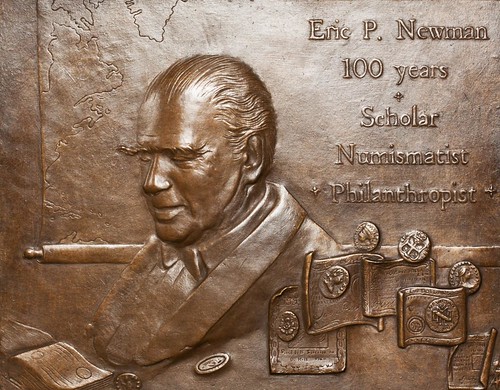
MORE ON ERIC NEWMAN
Richard Mantia writes:
Now that Eric Newman is 100 years old I wanted to take a moment to simply say Happy Birthday and THANK YOU to him. His greatest achievement is not reaching 100 years of age, but of the lasting legacy of knowledge and the benefit to society that he has provided us. He truly is the living embodiment of Benjamin Franklin's philosophy in "doing good" for the world. Mr. Newman has taught us all about ourselves by uncovering facts and re-discovering our history.
Medallic tributes to him are certainly befitting, but the best honor that can be bestowed upon him is the inspiration others find in his life and the new discoveries that are made because of his pioneering works. His museum and foundation are examples of a man who cares and who is humble about what he has achieved. It has been said that "Great Men" aren't born to greatness, they become great by their actions and Eric Newman is such a man and "Great" is a word most appropriate for him. He clearly is a great numismatist, a passionate scholar, but he is an even greater human being because of his deeds. I have met him once in person and was honored then.
Thank you Mr. Newman for a century of life and for making the world a better place! The world needs more people like you in it. Perhaps if I can keep my mind active with research and make positive contributions to society then I may too live as long.
In the fine tradition during "The Age of Enlightenment", I close with.
Respectfully and Humbly, Your most Obedient Servant,
Richard Mantia
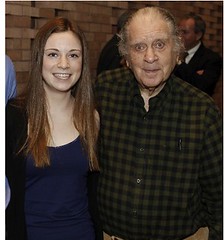 "Everything's happened to me in the world," said Mr. Eric P. Newman, one of the students who witnessed the opening day of John Burroughs School. On Friday May 20th, The World was fortunate to have the opportunity to sit down with Mr. Newman at the home he shares with wife Evelyn, just three days before his hundredth birthday. Upon entering the Newman household, the history that has permeated Mr. Newman's life becomes almost tangible with each step.
"Everything's happened to me in the world," said Mr. Eric P. Newman, one of the students who witnessed the opening day of John Burroughs School. On Friday May 20th, The World was fortunate to have the opportunity to sit down with Mr. Newman at the home he shares with wife Evelyn, just three days before his hundredth birthday. Upon entering the Newman household, the history that has permeated Mr. Newman's life becomes almost tangible with each step.
The John Burroughs community knows Mr. Newman as the namesake of the annual Newman Prize for juniors. However, what you may not know is that Mr. Newman was involved in a WWII naval battle while on his honeymoon, has a collection of 10,000 books and pamphlets of coins and paper money, interpreted a scene from Shakespeare's Hamlet that no scholar had ever analyzed before, attended MIT, traveled to all seven continents, published his findings on Audubon birds, is a self-described "ice cream-aholic," and, most significantly, attended the opening day of John Burroughs School in 1923.
Mr. Newman explained that John Burroughs began as a neighborhood effort for a co-educational school with a trolley that ended its path where, what is now Laughing Lake, began. Since the school had not completely finished renovations on Mr. Newman's first day, he states, "They handed me a shovel and we went to work digging a trough for the plumbing."
During his time at Burroughs, he fostered his love for history. Sprouting from this love of history came a love of coin collecting. Every three or so weeks, after young Eric Newman had saved enough of his allowance, he would travel on a downtown streetcar to St. Louis Stamp and Coin Store to purchase a new coin for five cents. One day, the owner, Mr. Johnson told him, "Eric, I wont sell this to you for five cents. Here is a book. If you can come back and recite to me what you know, I will sell you this coin." From that day on, Mr. Newman has gotten his hands on any book within his reach, as demonstrated by the large collections of books located all over the house.
Mr. Newman has been a lifelong historian and explorer, traveling to Europe for the first time in his Freshman year, and then again as a Junior. "Traveling is without doubt the most educating experience anyone can have," says Mr. Newman of his years of globetrotting. From Mongolia, Afghanistan, New Guinea, and the islands of the Indian Ocean, to Mozambique, Syria, Kuwait, Qatar, and Spitsbergen (as near to the North Pole as you can get), Mr. and Mrs. Newman have visited every continent at least five times. Upon first hearing this fact, The World inquired if Mr. Newman meant all but Antarctica, to which he responded, "O pardon me, Antarctica we've only been to once."
To read the complete article, see: ERIC P. NEWMAN (26) TURNS ONE HUNDRED YEARS OLD! (theworld.jburroughs.org/?p=2202)
Anyone who doubts that a man who has reached his 100th year could still have a sense of humor has never met Eric P. Newman.
Shortly before his 100th birthday on May 25, he was asked how he would like to be remembered and Newman quickly responded, "I am not dead yet so do not write a premature obituary."
"My mother died when she was 55 and my father when he was 65 I'm the lucky one," Newman said. "Medicine and numismatics have kept me alive."
To read the complete article, see: Eric P. Newman reflects on life, looks ahead (www.coinworldonline.com/articles/eric-p-newman-reflects-on-life-looks-ahead/)
Here are a couple photos of the presentation of Eric's Rittenhouse Society medal. That's Dick Johnson presenting the medal to Eric.

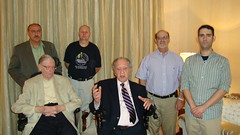
Ben Weiss writes:
In regard to the recent award to Eric Newman, your readers of e-sylum might be interested in hearing this oral interview of Eric Newman.
Interview of Eric P. Newman by John Adams and John Sallay
John Adams and John Sallay interview Eric P. Newman, longtime collector and author specializing in Early American numismatics. In this hour-long, two-part interview, conducted in 2009, Eric discusses his early years as a collector, his relationship with Burdette G. Johnson, their purchase of much of the Col. Edward H. R. Green collection, and his more recent activities with his numismatic foundation and museum.
The complete interview may be heard online on the section on Oral History of Medalic Art on the The Medal Collectors of America's website (below).
READER COMMENTS ON THE WOODWARD & LOTHROP STORE COIN DEPARTMENT
Kerry Rodgers found this item on the Woodward & Lothrop department stores on Wikipedia:
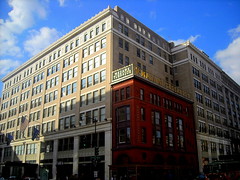 Woodward & Lothrop was a department store chain headquartered in Washington, D.C. Woodward & Lothrop was Washington, D.C.'s first department store, opening in 1887. Woodies, as it was often nicknamed, maintained stores in the Mid-Atlantic United States. Its flagship store was a fixture of the shopping district in downtown Washington.
Woodward, Lothrop & Cochrane opened at 705 Market Space at the intersection of Pennsylvania Avenue and 7th Street Northwest (now the United States Navy Memorial). The first store was so successful that within a year, they moved to a larger location at 921 Pennsylvania Avenue. Woodies expanded into suburban shopping malls after World War II.
Woodward & Lothrop was a department store chain headquartered in Washington, D.C. Woodward & Lothrop was Washington, D.C.'s first department store, opening in 1887. Woodies, as it was often nicknamed, maintained stores in the Mid-Atlantic United States. Its flagship store was a fixture of the shopping district in downtown Washington.
Woodward, Lothrop & Cochrane opened at 705 Market Space at the intersection of Pennsylvania Avenue and 7th Street Northwest (now the United States Navy Memorial). The first store was so successful that within a year, they moved to a larger location at 921 Pennsylvania Avenue. Woodies expanded into suburban shopping malls after World War II.
To read the complete article, see: Woodward & Lothrop (en.wikipedia.org/wiki/Woodward_%26_Lothrop)
Kerry also found this 2009 Washington Post reference:
We called it "Woodies." I come from a family of shopaholics. We shopped the Woodies in Friendship Heights, the one in Wheaton and in Montgomery Mall, but there will never be a store like the one that was in the heart of downtown with the North and South buildings.
It was the total experience of being in a large urban department store -- the impressive main aisle that ran from the G Street entrance to the F Street entrance. I remember the always crowded area by the row of elevators, the very cool Down Under section that connected the two buildings when Metro came to town in 1976; the stamp and coin department and the large, luminous chandeliers above the endless perfume, makeup and jewelry areas on the first floor.
Loren Gatch writes:
I don't know about the store in downtown D.C., but as a teenager in the early 1970s I spent many hours in the coin department of "Woodies" at the Friendship Heights location (the corner of Willard and Wisconsin Aves, across from the old Howard Johnson's). This was before the Metro was built, and the area was pretty sleepy compared to now. I wasn't aware who ran the department, but I remember thinking the clerks weren't terribly expert in numismatics. Still, they were unfailingly polite and patient with my leisurely forays through their inventory. I also remember their distinctive use of paper envelopes, rather than 2x2s, to store their coins. It allowed me to physically hold each coin I looked at, a luxury less available nowadays when so many coins are "slabbed" away from human touch.
Russ Sears writes:
Woodward & Lothrop actually had two coin departments. One was in D. C. at 10th, 11th, F & G Streets and the other in one of the suburbs, I think Chevy Chase. The coin you showed along with its original envelope was from the D. C. store (see DC on the envelope).
Nelson Whitman, an expert in both coins and political artifacts and who is still seen at various coin shows around the area, was the manager of the downtown store for many years. Both stores were owned by the Friedbergs as was the store where I worked in Baltimore, Hutzler's. At one time, the Friedbergs had about three dozen coin shops
Joe Levine writes:
This was one of a large number of department store outlets owned by the Friedberg's Coin and Currency Institute. For years it was run by Nelson Whitman. When it closed, Nelson opened up Capitol Stamp & Coin Company in Washington, D.C. which he still operates.
Pete Smith writes:
The E-Sylum has mentioned Robert Friedberg who set up coin departments in major department stores. I recall an attempt to list all the publications ofThe Coin and Currency Institute. Perhaps someone could attempt to list all the department stores where they had their shops.
Nelson Whitman was manager of the coin shop in Woodward & Lothrop for 18 years. He was later the owner of Capitol Coin and Stamp Company in Washington. I don't know if this company has any association with Capitol Coin Company owned by Friedberg. Whitman was born on 11/12/1936. Attached is an image from the Capitol Coin & Stamp web page. I assume this is Whitman but he is not identified.
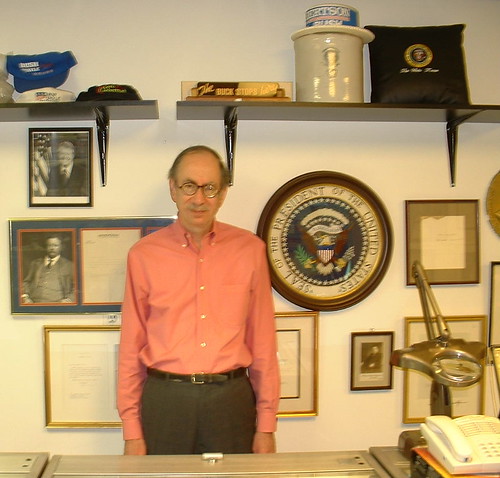
To visit the Capitol Coin & Stamp web site, see: capitolcoin.com
Tom DeLorey writes:
As a small aside to the item about the 1842-O $10 sold in the coin department at the Woodward & Lothrop department store, a great American numismatic rarity was once discovered in a cash register at Woodward & Lothrop!
Back when I was working at Coin World, we received in a Bicentennial dollar struck in Proof on a 40% silver planchet without a mint mark! What's more, the coin displayed the Type Two reverse, unlike the no mint mark trial strikes known to have been struck in 1974 with the Type One reverse.
When I queried the submittor, he said that the coin had been found in a cash drawer at the Woodward & Lothrop department store in Washington, D.C. I speculated that some Treasury or Congressional personage had simply spent it there, but of course nothing was ever proven.
At the time the coin showed evidence of minor circulation handling, but I understand that the circulation has since gone away.
To read the earlier E-Sylum article, see: QUERY: WOODWARD AND LOTHROP DEPARTMENT STORE COIN SHOP (www.coinbooks.org/esylum_v14n22a13.html)
THE BOOK BAZARRE
NOTES FROM E-SYLUM READERS: JUNE 5, 2011
Some E-Sylum Delivery Problems
Ken Berger writes:
I received the most recent copy of The E-Sylum at my two email addresses. Although I got the complete E-Sylum at my college email, at my Juno email The E-Sylum was truncated at the end of the Daniel K E Ching's Rice Bowl Collection paragraph. I can only assume that Juno has a limit on the size of attachments. Was the most recent E-Sylum larger than other previous ones? I wonder if other subscribers have encountered a similar problem.
On Greaseproof Paper
Philip Mernick of London writes:
Regarding Joe Boling comment on greaseproof paper: I think "greaseproof" was right rather than "greased". The term is used here for a heavy paper with low porosity used in baking or confectionery. It is still available and would have been found in most 1930s/40s homes.
To read the earlier E-Sylum article, see: NOTES FROM E-SYLUM READERS: MAY 29, 2011 (www.coinbooks.org/esylum_v14n22a20.html)
The Pope's Space Coin

Silver Circulation Through 16th18th Century Spain
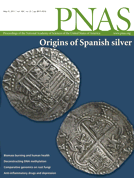 Estimating global fluxes of precious metals is key to understanding
early monetary systems. This work adds silver (Ag) to the metals (Pb
and Cu) used so far to trace the provenance of coinage through
variations in isotopic abundances. Silver, copper, and lead isotopes
were measured in 91 coins from the East Mediterranean Antiquity
and Roman world, medieval western Europe, 16th18th century
Spain, Mexico, and the Andes and show a great potential for provenance
studies. Pre-1492 European silver can be distinguished from
Mexican and Andean metal. European silver dominated Spanish coinage
until Philip III, but had, 80 y later after the reign of Philip V, been
flushed from the monetary mass and replaced by Mexican silver.
Estimating global fluxes of precious metals is key to understanding
early monetary systems. This work adds silver (Ag) to the metals (Pb
and Cu) used so far to trace the provenance of coinage through
variations in isotopic abundances. Silver, copper, and lead isotopes
were measured in 91 coins from the East Mediterranean Antiquity
and Roman world, medieval western Europe, 16th18th century
Spain, Mexico, and the Andes and show a great potential for provenance
studies. Pre-1492 European silver can be distinguished from
Mexican and Andean metal. European silver dominated Spanish coinage
until Philip III, but had, 80 y later after the reign of Philip V, been
flushed from the monetary mass and replaced by Mexican silver.
On Cell Phone Coin Photos
Roger Siboni writes:
In response to Bruce Smith's question, I use a an iPhone with a "Camera Plus" application to enhance the picture quality. It works pretty well for my day to day needs. But for my primary set of coin photographs, I rely on Neil Rothschild who has a fairly sophisticated copy stand, high end digital camera(s) and a ring flash. Then he runs the photos through a set of algorithmic processes with Photoshop to get true color. Coins are a hard thing to photograph well.
Notes from Joe Boling
Joe Boling writes:
About the ANA's use of the NBS gift, it's great to place 19th century auction catalogs in acid-free envelopes, but is anything being done to neutralize the catalogs themselves, to prevent self-destruction within their now-buffered environments?
Looking at the six-medal lineup associated with the story about Graco Awards joining Northwest Territorial Mint, I was struck by the third medal, inscribed "Vietnam Service." It does not match any medal known to me for the US uniformed services. For whom was that medal created? The other five are the Purple Heart, the Silver Star, the Air Force Achievement Medal, the Soldiers Medal, and the Defense Superior Service Medal. That VN Service Medal had to have been created for some non-military agency. For whom?
On to Dick Johnson's treatise on phaleristics: be careful of using terms like "never." Many US decorations are round - some of the several distinguished service medals at the top, going down to some of the commendation and achievement medals, and the good conduct medals. All of these are above the class called "service medals." And we do have one decoration that comes in degrees, such as orders do - the Legion of Merit. As it happens, US citizens may receive only the lowest degree (Legionnaire), but there are three above it, progressing in complexity and gaudiness - Officer, Commander, and Chief Commander. These are awarded to foreign dignitaries (which can include heads of state, so not necessarily only military recipients).
Serge Pelletier writes:
Thanks to fellow terminology enthusiast Dick Johnson, I've discovered a new term. In his paper, Dick says that decorations are never round. Well, I'm sad to say that is false. In the Canadian Honours System there are decoration that are round, such as the Medal of Bravery, which, by the way, was the subject of a circulation 25-cent piece and a collector 1-dollar piece in 2006.
For more information on the Canadian Honours System visit the Governor General's website at: http://gg.ca/document.aspx?id=67
MORE ON THE COREY'S OINTMENT COUNTERSTAMP
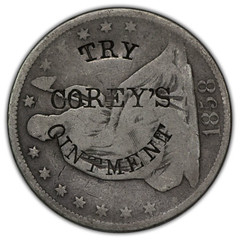
Joe Boling writes:
I wonder what were the origins and termini of the (apparently several) trans-Atlantic railways along which John Dent saw ads for Corey's Ointment. Were diving bells provided to the passengers?
To read the earlier E-Sylum article, see: NEW INFORMATION ON THE COREY'S OINTMENT COUNTERSTAMP (www.coinbooks.org/esylum_v14n22a16.html)
AMERICAN COINS IN THE SHORTHOUSE COLLECTION
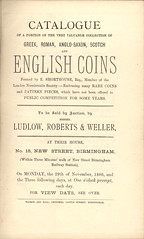 The job of being a numismatic book dealer is a rewarding one, even if I don't exactly earn a fortune.
The job of being a numismatic book dealer is a rewarding one, even if I don't exactly earn a fortune.
In this business it is all too easy to accumulate hoards of material. Let me say that I do not have the problem that many collectors have, of a wife who resents their husband's collection. My wife, whilst not perhaps quite as crazy as I am about books, is very fond of them, and when a freshly-bought library arrives she eagerly and happily helps to catalogue it and put it onto the shelves, either for sale, or onto our library shelves, but there are times when it overflows. It goes into boxes and sits until there is time to deal with it. In this case, the pile of boxes was started about fifteen years ago. Last week it became apparent that something had to be done about it as what had been intended as a verandah has now become a junk storage facility. and there are times when even I realise that if I want to buy more, something has to go !
In this instance, the fifteen-year old pile had got to go, but before that, it had to be sorted and what was saleable had to go for sale on our website (www.galata.co.uk) Much of it is junk, or at least, it was fifteen years ago. The pile is large: two cubic yards would not be an exaggeration. I started at one corner and began to work my way downwards and inwards. It consists of things such as a long run (of fairly recent copies) of The Numismatist, and Coin Monthly, that were put to one side just in case someone might want them. If anyone does, please let me know, they are free but you'll have to pay the carriage, and preferably come to collect them. Now, let me say that 15 years ago things were different - I didn't rate auction catalogues that highly, but people began to appreciate them, and my attitude has changed towards them as there are now several good customers for them. One box, therefore, brought quite a lot of joy, as many were Sotheby catalogues from the early 1900s, and another was a strange catalogue, which I thought that I would share with you, as most of those who read this are interested in things American
It is hard bound, with a textured, dark blue, nearly black cover, just over five inches wide and eight and a half inches tall. Whilst obviously of some age, it does not look as old as it is, surviving from 1886.
The title page informs :
of a Portion of the Very Valuable Collection of
Greek, Roman, Anglo-Saxon, Scotch and
ENGLISH COINS
GOLD, SILVER AND COPPER
Formed by E. Shorthouse, Esq., Member of the
London Numismatic Society: Embracing many RARE COINS
and PATTERN PIECES, which have not been offered to
PUBLIC COMPETITION FOR SOME YEARS
A BOOK AS RARE AS YOUR COINS. . . .
AN ODD AND CURIOUS CURRENCY: CIGARETTE BOXES IN GERMANY
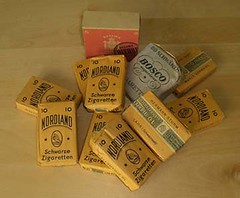 Time and again the happiness has been described a collector experiences when at a coin fair he finds the one, the small and seemingly insignificant object that nobody else recognizes. Something similar happened to the author on a flea market in the city of Staufen at the foot of the Black Forest. Among the masses of old dishes and tattered novels a small container laid filled with old cigarette boxes. When asked, the sales woman replied that she lived on a farm and that she had found these boxes lying on a heap.
Time and again the happiness has been described a collector experiences when at a coin fair he finds the one, the small and seemingly insignificant object that nobody else recognizes. Something similar happened to the author on a flea market in the city of Staufen at the foot of the Black Forest. Among the masses of old dishes and tattered novels a small container laid filled with old cigarette boxes. When asked, the sales woman replied that she lived on a farm and that she had found these boxes lying on a heap.
The situation was quite clear: we were facing a hoard of currency, albeit an unusual one. They were specimens from the post-war era when cigarettes used to be Germany's unofficial means of payment. May be the farmer had traded them for potatoes, eggs and butter. Since he possessed food, he had become such a "rich" man that he was not forced to instantly barter all cigarettes for commodities but hide some boxes in a small hoard for worse times.
Some prices in cigarette currency:
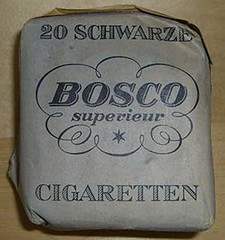 1.5 kg bread or bread ration food stamps → 10 cigarettes
1.5 kg bread or bread ration food stamps → 10 cigarettes
1 chicken → 30 cigarettes
100-150 g meat or meat ration food stamps → 10 cigarettes
1 quilt cover → 125 cigarettes
75 g butter or butter ration food stamps → 10 cigarettes
15 g ground coffee → 10 cigarettes
25 g tea → 10 cigarettes
250 g sugar or sugar ration food stamps → 10 cigarettes
1 goose → 250 cigarettes
Hence, our little hoard represents the equivalent value of 4 Ό chicken or a quilt cover plus 15 g of ground coffee.
The American-blend-cigarettes, especially the trademarks Lucky Strike, Chesterfield and Camel, were the most popular because with their blend they fought hunger most effectively. On the black market, therefore, one got 5 to 40 Reichsmark for an "ami", in contrast to 3 to 12 Reichsmark for a German cigarette - quite a lot of money all the same; after all, in 1946/47 a German worker working in the luxury food industry earned 96 Reichspfennige an hour, officially he had to pay 16 for a German cigarette. An average worker, then, had to work roughly 7 hours to pay his 40 cigarettes per month.
The "cigarette hoard" presented here consists solely of cigarettes produced in Germany - even though the "amis" dominated the market, Germany's own production did not come to a halt altogether.
It is safe to assume that only very few visitors the Staufen flea market had realized that the small jar contained an extraordinarily rare testimony of our own past that most of us - even though not eye-witnesses on the post-war era are still familiar with due to the stories we heard from older relatives.
To read the complete article, see:
A relic from Germany's post-war era: a hoard of cigarette boxes
(www.coinsweekly.com/en/A-relic-from-Germanys-post-war-era
-a-hoard-of-cigarette-boxes/8?&id=35&type=a)
GOLD, SILVER BECOMING LEGAL CURRENCY IN MORE STATES
State legislatures concerned with rampant printing of money by the nation causing a weaker dollar are responding by making precious metal legal tender to circulate. Utah is the first state to pass legislation that makes bullion coins legal tender.
"Lawmakers in Minnesota, North Carolina, Idaho and several other states are proposing measures similar to the one in Utah," states Forrest Jones in a Moneynews article, May 27, 2011. "South Carolina lawmakers are proposing a bill that would do just that based in part on concern that present monetary policies may be undermining the national economy."
Ralph Danker, a project director for economics at American Principles in Action, Washington, DC, stated "Making gold and silver [bullion] coins legal tender sends a strong signal to Congress and the Federal Reserve that their monetary policy is failing. Danker and his organization helped shape the new Utah law.
He added "The dollar should be backed by gold and silver, so we have hard money."
You can read the full article at: Gold, Silver Becoming Legal Currency in More States (www.moneynews.com/StreetTalk/Gold-Silver-Legal-Currency/2011/05/27/id/398039)
BIBLIOMANIACS: HIGH ON LITERATURE?
HIGH ON LITERATURE: The fungi that feed on old paper may be mildly hallucinogenic, and may cause an "enhancement of enlightenment" in readers, says a report in the British medical journal The Lancet. The source of inspiration for many great literary figures may have been nothing more than a quick sniff of moldy books, the report says.
FEATURED WEB SITE: GEORGE WASHINGTON INAUGURAL BUTTONS
This week's Featured Web Site is suggested by Ray Williams. It's still under construction, but looks like great resource on the topic of George Washington inaugural buttons. Thanks!Welcome to the new 2011 George Washington inaugural button reference site for collectors & enthusiasts. This site's main goal is to help people find out all the history and information they can on 1789 or 1793 George Washington inaugural buttons, and other Washington medalets. My goal is to make this information available to everyone interested in the field of American Politicana.
The various George Washington Inaugural Buttons are displayed by each of the 27 known Varieties, which in-turn contain the 52 known Sub-Varieties. Finding your button, or the one you are researching should be easy with our picture reference layout. This site's main goal is to give the clearest possible images, so making identification and matching buttons in our archives straightforward and uncomplicated. Over the last 20 years, the influx of new treasure hunter finds with Metal Detectors has turned up an unprecedented & undocumented number of George Washington inaugural buttons and medalets. This site will allow for these new buttons to be properly documented.
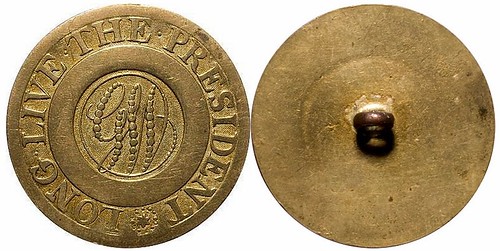
georgewashingtoninauguralbuttons.com
